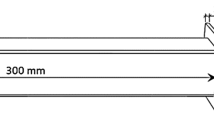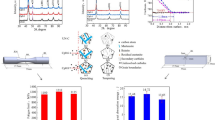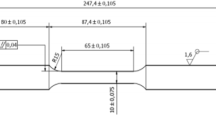Abstract
Corrosion has been one of the main structural degradation processes and has been the root cause of many engineering structural failures around the world. Therefore, proper understanding of corrosion process and especially residual strength measurement is an important consideration in the engineering discipline. This study was performed to find the residual strengths of partially corroded steel using a cost effective reliable method which can be adopted easily. For that, Average Weight Ratio (AWR) was introduced instead of the Minimum Thickness Ratio (MTR), proposed by previous researchers. In this context, partially corroded steel specimens were subjected to accelerated corrosion tests in a corrosion incubator. There, correlations were built between hardness verses AWR, ultimate tensile strength verses AWR and ultimate tensile strength ratio verses AWR of partially corroded steel.
Access provided by Autonomous University of Puebla. Download conference paper PDF
Similar content being viewed by others
Keywords
1 Introduction
The use of steel structures all over the world increased gradually due to its many advantages such as its versatility, high strength, uniformity, ease of use, toughness, ductility and many other properties. Structural steel has very high yield strength for compression and tension. Therefore, it is convenient to use structural steel as a building construction material than other construction materials such as concrete, timber, etc.
But one of the major disadvantages of using steel as a construction material is the fast deterioration in steel due to corrosion when exposed to aggressive environmental conditions and poor maintenance. Because of this, reduction in their strength capacities, corrosion wastage, fatigue cracking, or mechanical damage may occur during their service life. Therefore significant issues occur on safety, health, environment and financial costs. The catastrophic collapse of the silver bridge on Ohio River in 1967, USA is a classic example for structural failure due to corrosion.
Therefore, it is essential to carefully evaluate the remaining strength of steel structures to understand the feasibility of the steel structure for future usage. Several experimental studies and detailed investigations have been done by some researchers during the past few decades, to introduce methods of estimating the remaining strength of corroded structural steel members (Appuhamy et al. 2011).
This research study is mainly based on developing a simple and convenient method to estimate residual ultimate tensile strength and yield strength of the corroded structural steel specimens. Experimental results were used to develop and determine more reliable results. Those developed results can be used for the existing corroded structures by measuring the remaining thickness and calculating the average thickness ratio with respect to initial thickness and thereby, the remaining strength can be easily calculated.
2 Theoretical Background
It has been mentioned that regular coarse surface measurement could be sufficient for minor corrosion members as surface roughness does not affect minor corrosion. Therefore, for our experiments, average thickness ratio (ATR) was considered instead of minimum thickness ratio (MTR).
Considering that the density of steel remained unchanged and only thickness is reduced rather than length and breadth, it can be proven that average thickness ratio is equal to average weight ratio as below.
As considering unchanged of length (L) and breadth (B)
Hence,
2.1 Corrosion Acceleration
Corrosion accelerates due to factors such as the over potential, the aggressive medium, the temperature and the concentration. However, the materials react differently to different types of electrolytes. The accelerated corrosion test is done to obtain results in a shorter period of time than from natural exposure. In general, accelerated corrosion tests can be performed increasing temperature and potency with time to get different corrosion levels.
2.2 Techniques for Inducing Accelerated Corrosion of Steel
Corrosion of steel is a slow process in the natural environment under normal conditions. It takes reasonably long time to achieve a significant degree of corrosion in steel. Different types of techniques were introduced to accelerate corrosion in past research studies. One of it is “Impressed current technique” which is a method to induce significant corrosion in a short period of time to steel embedded in the concrete.
Further, another alternative technique for inducing accelerated reinforcement corrosion is to build up artificial climate environment in the room which controlled by a computer system. In that artificial climate room, environmental condition, temperature, relative humidity and repeated wetting and drying cycle consisted of salt water (5% NaCl solution) spraying for 1 h and infrared light shining for 7 h were controlled. This test set up is shown in Fig. 1 (Ahmad 2009)

(Source: Ahmad 2009)
Set-up for accelerating reinforcement corrosion in large-size reinforced concrete beam specimen.
2.3 Correlations Among Mechanical and Strength Properties
In addition to yield strength and ultimate tensile strength of steel, hardness is an important mechanical property which can be measured using hardness testing machines. The above strengths can be found according to formulae among hardness, yield strength and tensile strengths, which have been developed by past researches. Of them, the following formulae are very convenient to study;
(Pavlina and Van Tyne 2008)
where, TS = Tensile strength
YS = Yield strength
H = Diamond pyramid hardness (Vickers hardness)
n = Strain-hardening exponent (n = 0.21)
Further Residual Ultimate Tensile Strength of corroded steel could be determined using the following formula by substituting Brinell hardness number.
(Pavlina and Van Tyne 2008)
where,
HB = Brinell hardness
In addition to the above developed formulae, many conversion tables among hardness and tensile strengths of steel have been developed by recognized organizations.
2.4 Yield to Tensile Strength Ratio (YTR) of Steel
It is a very important parameter to determine Yield Strength of steel when the Ultimate Tensile Strength of particular steel is known. Normally YTR of range from 0.5 to 0.9 is recommended for steel (Gasko and Rosenberg 2011).
3 Experimental Set up
Two experiments were performed and the following gives the details of these experiments.
3.1 Experiment 1
Accelerated corrosion test was performed in an incubator where temperature and potency with time was controlled to check the feasibility of selected corrosion accelerated factors to be used for experiment 2 which was done to observe different corrosivity levels of specimens by changing one control factor with respect to others.
-
1.
Two numbers of 50 × 20 × 3 mm steel specimens were prepared out of Grade S 275 structural steel (one of them was selected as a standard specimen while the other was subjected to corrosion).
-
2.
A glass tank (300 × 200 × 150 mm), (12 V–28 V) capacity DC transformer, thermostat (30 °C–50 °C), 0.125 M Sodium Chloride solution (as a catalyst) and flexible wire pieces were used to prepare an incubator.
-
3.
Two numbers of 50 × 20 × 3 mm structural steel specimens were submerged in the sodium chloride solution and connected to a 12 V power supply to create corrosion on surfaces of steel specimens (in 30 °C temperature).
-
4.
The specimen connected to the cathode end acts as a standard specimen while the other specimen attached to the anode end corroded with time.
-
5.
The above procedure was repeated twice for increasing temperature (35 °C) and increasing voltage (28 V) respectively (Fig. 2).
3.2 Experiment 2 - Phase I
Experiment 2 (Phase I) was performed to get different corrosivity levels of steel. Corrosivity levels were evaluated as a measure of Average Weight Ratio instead of average thickness ratio according to the above proof.
Initial weight of each specimen (W0) was measured using a digital scale.
The glass tank was filled with 4 L of 0.125 M NaCl solution. The electric heater coupled to the thermostat was inserted to the glass tank and temperature of the thermostat was adjusted to 30 ℃.
The test specimen to corrode was connected to the anode end of the 12 V DC power supply while another specimen was connected to the cathode end of the power supply and both specimens were inserted to the solution and the power supply switched on.
After an hour, the corroded steel specimen was removed from the solution and the rust of the specimen was removed thoroughly.
-
Then, the final weight of the specimen was measured.
-
The above steps were repeated by increasing the time period and the solution was removed and refilled for each repetition.
-
The same procedures were adopted for the other experiments by increasing the voltage and temperature as (12 V, 35 °C), (28 V, 30 °C), (28 V, 35 °C) and (28 V, 40 °C) respectively (Fig. 3).
4 Results
A considerable number of experiments were performed and the relationships with AWR obtained are shown in Figs. 4, 5, 6, 7 and 8.
4.1 Identify Correlations to Find Out Residual Strengths
From the graph of Rockwell hardness verses average weight ratio, when average weight ratio decreases, Rockwell hardness value decreases accordingly producing a linear correlation between those two parameters up to a certain extent of moderate corrosivity as shown in Fig. 4.
By scrutinizing the rest of the graphs, similar linear correlation could be identified between Brinell hardness verses average weight ratio, Vickers hardness verses average weight ratio, ultimate tensile strength verses average weight ratio and ultimate tensile strength ratio verses average weight ratio as shown in Figs. 5, 6, 7 and 8.
Residual ultimate tensile strength of partially corroded structural steel could be determined using the graph of ultimate tensile strength ratio verses average weight ratio if the initial ultimate tensile strength was known. That obtained value can justify by using Eq. (3),
Brinell hardness value is obtained from the graph of Brinell hardness verses average weight ratio.
Residual yield strength of partially corroded structural steel could be calculated by substituting Vickers hardness value obtained from the graph of Vickers hardness verses average weight ratio to Eq. 2. That obtained value is to be multiplied by 9.81 as it is given kgf/mm2 and the unit of residual yield strength is N/mm2.
If yield to tensile strength ratio (YTR) is known, residual yield strength value could be obtained by substituting residual ultimate tensile strength value and the above residual yield strength value could be verified.
5 Conclusion
The residual strength measurements were conducted for partially corroded structural steel and the following conclusions can be made from this study. The corrosion causes strength reduction of structural steel members and average weight ratio (AWR) can be used as the measure of the level of corrosion. The experimental and analytical results can be used to predict the residual strength of actual corroded members accurately.
References
Ahmad S (2009) Techniques for inducing accelerated corrosion of steel in concrete. Arab J Sci Eng 34(2C):95 Department of Civil Engineering King Fahd University of Petroleum & Minerals Dhahran, Saudi Arabia
Appuhamy JMRS et al (2011) Analytical study on significance of corroded surface measurement on residual strength prediction. Proc Eng 14:2260–2268
Gasko M, Rosenberg G (2011) Correlation between hardness and tensile properties in ultra-high strength dual phase steels – short communication. Mater Eng 18:155–159
Pavlina EJ, Van Tyne CJ (2008) Correlation of yield strength and tensile strength with hardness for steels. J Mater Eng Perform 17(6):888–893
Acknowledgment
Authors would like to thank to Dr. C.S. Bandara of Civil Engineering Department in University of Peradeniya for the support given in this research.
Author information
Authors and Affiliations
Corresponding author
Editor information
Editors and Affiliations
Rights and permissions
Copyright information
© 2020 Springer Nature Singapore Pte Ltd.
About this paper
Cite this paper
Karunananda, P.A.K., Kariyapperuma, K.A.D.D.T., Weeraratne, R.P., Sanjeewani, H.D.M. (2020). Experimental and Analytical Study of Residual Yield and Tensile Strengths in Partially Corroded Structural Steel. In: Dissanayake, R., Mendis, P. (eds) ICSBE 2018. ICSBE 2018. Lecture Notes in Civil Engineering , vol 44. Springer, Singapore. https://doi.org/10.1007/978-981-13-9749-3_48
Download citation
DOI: https://doi.org/10.1007/978-981-13-9749-3_48
Published:
Publisher Name: Springer, Singapore
Print ISBN: 978-981-13-9748-6
Online ISBN: 978-981-13-9749-3
eBook Packages: EngineeringEngineering (R0)











